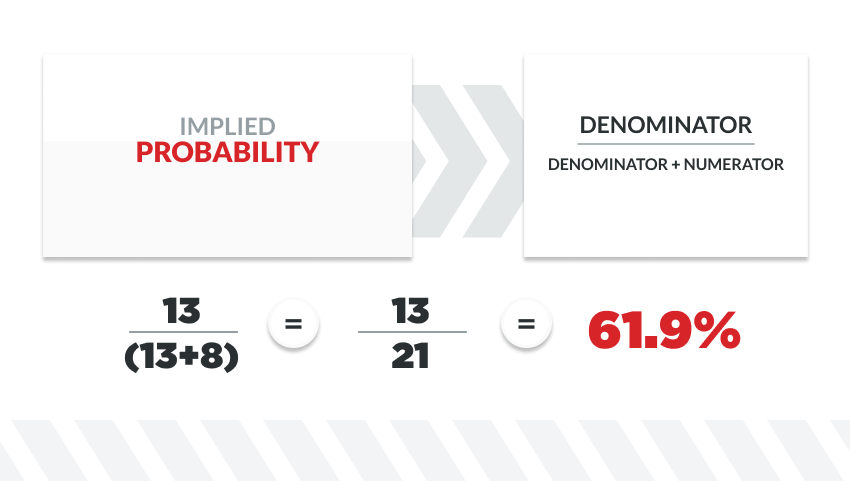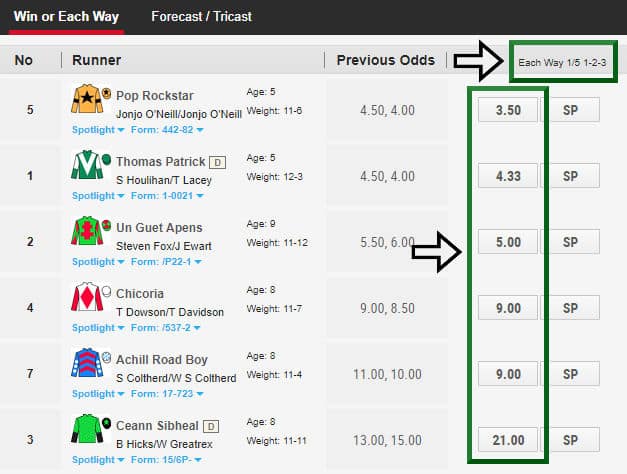Odds Explained
Posted : admin On 4/11/2022
- Horse Racing Betting Odds Explained
- Odds Explained Football
- Odds Explained 1 In 2.5
- Odds Explained Differences
- Baseball Odds Explained
- Odds Explained 13/10
- Racing Odds Explained
- Sports Betting Odds Explained Point Spread - If A Football Team Is -7, Then That Team Must Win By 8 Points To Win The Bet. Over / Under ' AKA The Total' - If An Over / Under Is 42 In A Football Game, The Combined Total Amount Of Points Both. Moneyline Betting Odds - If The Money Line Has “Team A”.
- The three main types of betting odds are fractional (British) odds, decimal.
- That’s pretty much everything you need to know about betting odds and how they work. In a nutshell, betting odds give us a rough probability of an event occurring and they tell us how much money our bet will return if it wins. Don’t worry if things still feel a little alien at this point.
So, what are Pot Odds?
In poker, pot odds are the ratio between the size of the pot, including bets made in the current round, and the cost of a call to try to win the pot. For example, if there are 10$ in the pot, and your opponent bets 5$, you need to pay 5$ to potentially win 15$. Therefore, your pot odds are 3 to 1.
Horse Racing Betting Odds Explained
“Pot odds” is a great tool that many top poker players use when they are facing a decision. By comparing pot odds to the probability of winning the hand, one can deduct if calling is profitable or not. So, it works like expected value, helping you make the right choice, but reduces the necessary calculations.
When faced with a bet, to calculate your pot odds, you only need to compare the money that you will gain if you win the hand, the current pot including your opponent’s bet, to the money required to make the call. Then, to choose the right course of action, you must compare these pot odds to your estimation of the odds against you winning the hand.
If the pot odds are higher than the odds against you winning the hand, it means that when you win, you will be extracting enough of a reward to make the call worth it! On the contrary, if the pot odds are lower than the odds against you winning the hand, the amount that you will be gaining when you win will not make up for the losses. So, in this case, the right action is to fold.
Fixed-odds betting is a form of wagering against odds offered by a bookmaker or an individual or on a bet exchange. It involves betting on an event in which there is no fluctuation on the payout. In Australia, the practice is usually known as 'SP betting' Calculating fixed odds.
Mathematical Explanation of Pot Odds
Let’s work some simple math to show the reasoning behind using pot odds as a shortcut. If a call has +EV (the same proof applies for -EV), this means that:
EV (Call)= P(win) * $(pot)- P(lose) * $(call) > 0, or
P(win) * $(pot) > P(lose) * $(call), and by deviding by P(win)*$(call)
$(pot) / $(call) > P(lose) / P(win)
So the pot odds (on the left of the equation) are higher than the odds against you winning the hand (on the right).

A Simple Example
We will demonstrate this concept with a relatively simple example.
You are facing two tight opponents. You are holding J♥9♠, and on the turn, the board is 10♥4♠8♣2♦, so you have a straight draw. The pot is 70$, and you have only 20$ more in your stack, while your opponents both have bigger stacks.
The first opponent to act goes all-in and the second opponent calls. So, what should you do?
How to Calculate Pot Odds?
To calculate the pot odds, you must compare the money that you may potentially win to the money that is required for making the call. You may win 110$ (70$ in the pot plus 20$ from each opponent) and need 20$ to make the call. Therefore, the pot is offering you 110 to 20, or 5.5 to 1.
Let’s now calculate the probability against you winning the hand. You have an open-ended straight draw (or up and down, two way). This means that you have two ways of making your straight (hitting a Queen or a seven) or a total of 8 outs. It is clear that one or both players have you beat. You are probably up against some combination of an overpair, two pair or a set. However, whatever your opponents have, all of your 8 outs will give you the nut straight.
Another aspect to consider is the possibility of another player drawing for the same straight. This possibility would make you split the pot when you make your hand and affect your calculations. However, given your starting hand and the fact that your opponents are tight, you are not concerned with one of them holding J9. So you can safely rule out sharing the pot when you hit your draw.
So, you have 8 cards that will make you win. The remaining 38 of the total 46 unseen cards will make you lose. The odds are 38 to 8 against you making your winning hand or 4.75 to 1. the pot odds you are being offered are better (5.5 to 1), making it a good call. This means that, even though you are an underdog to win the hand, the pot is offering enough of a reward to make the call worth it.
Calculating the Expected Value for Validation
You managed to reach the correct decision without doing the extra math of calculating the expected value. For demonstration reasons, the expected value of a call is:
EV = P(win)*$(win)-P(lose)*$(lose) = (8/46)*110 – (38/46)*20 = 2.61$
So on average, you win about 2.6$ each time you make that call.
Working with Percentages Instead of Odds

There are many software products, like Flopzilla or Equilab, that calculate your equity against an opponent’s range in terms of percentage. You can check out the tutorial on Hand Ranges to learn how to work with ranges. Whether you work with such software, or you are just accustomed to using percentages, you may want to be able to convert pot odds into percentages you can work with. Let’s look at how to do this.
To compare pot odds to equity percentages, you need to convert your pot odds to a percentage of your bet versus the final pot size, including your call. To do so, you have to:
First, divide the amount of the call by the size of the final pot. For example, if the pot is 10$ and you are facing a 5$ bet, you need to divide 5 (your call) by 20, the final pot amount, so you get 0.25.
Second, convert this into a percentage. By multiplying with 100, you can convert your result into a percentage you can work with. So, 0.25 equals 25%.
Now, to see if calling is +EV, you need to compare this percentage to your equity. If your equity is higher, the call has a +EV!
Conversion Table
| Pot Odds | Minimum Equity to Call |
|---|---|
| 1.5 to 1 | 40% |
| 2 to 1 | 33% |
| 3 to 1 | 25% |
| 4 to 1 | 20% |
| 5 to 1 | 16.7% |
Odds Explained Football
An Example Using Pot Percentages
Let’s take a look at a different example, this time using percentages.
A solid opponent raised preflop from the middle position, and you called from the button with K♥Q♥. The flop was A♥5♥4♠, and your opponent check-raised all-in your semi-bluff flop bet.
Odds Explained 1 In 2.5
There is 80$ in the pot, including your bet and your opponent’s all-in, and you have to call 40$ more to match his bet. What should you do?
Let’s calculate your pot odds in terms of percentage. To do so, you have to:
Odds Explained Differences
First, divide the amount of the call by the size of the final pot. So 40/120 = 0.33
Second, convert this into a percentage. We multiply 0.33 by 100 to get our percentage, 33%.
Now, we have o try to calculate your equity against your opponent’s range of hands he would go all-in with. You estimate that your opponent open-raises from middle position with a 15% range, like bellow.
Using Flopzilla we can see that, even if your opponent does not bluff and goes all-in with top pair or better, or a flush draw, like bellow, your equity is over 37%.
Since your equity against his range is higher than 33% (your pot odds in percentage), calling is +EV!
In a Nutshell
Baseball Odds Explained
Using pot odds is an excellent way of making quick estimations on the table and choosing the right course of action. Even when there are subsequent betting rounds, pot odds are useful as they can help you understand the value of what is already in the pot relatively to your stack. However, when there are subsequent betting rounds in the hand, you need to consider the possibility of winning extra bets when you hit your hand. This concept is known as implied odds, in contrast to the expressed odds that the pot is offering you at any given moment.
Odds Explained 13/10
In the next tutorial, we will present the concept of implied odds and how it is used to make educated decisions when there are further betting rounds. Please leave any comments or questions that you may have!
Racing Odds Explained
This tutorial is part of the Advanced Poker Strategy Course. You can continue to the next tutorial on Pot Commitment!